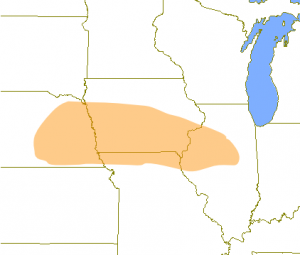Just What is General American English?
I’ve spent the last week on vacation with my girlfriend’s extended family. Most of them are from various parts of Pennsylvania, a state noted for its relative diversity of accents. Indeed, this was my experience throughout the week: I heard accents ranging from slightly Canadian-sounding (Northern/Central PA) to slightly Southern sounding (South/Western PA.)
And yet, as I suggested with my recent post about the Philadelphia accent, Pennsylvania is not much renowned for its accents. I believe this is because most accents in the Keystone state are only a few degrees removed from General American English (aka GenAm), the term used to describe American accents that aren’t overly Northern, Southern or Eastern. As such, PA accents haven’t gained the notoriety of more pronouncedly regional varieties of English.
But what accents, then, can be thought of as variants of GenAm? And at what point does an accent become “regional?”
Here’s the Wikipedia blurb about General American English, which sums up the commonly understood definition succinctly:
General American (GA), also known as Standard American English (SAE), is a major accent of American English. The accent is not restricted to the United States. Within American English, General American and accents approximating it are contrasted with Southern American English, several Northeastern accents, and other distinct regional accents and social group accents like African American Vernacular English.
So General American English is exclusive by definition. Nevertheless, it is often described as “typical,” “neutral,” or some other slightly biased adjective. After reading numerous definitions of GenAm, however, I’d say the term describes a spectrum of accents rather than a single monolithic standard.
In the narrowest sense, the General American “heartland” is found in a tiny chunk of the midwest. This map, created by an astute Wikimedia Commons contributor (extrapolated from the work of renowned linguist William Labov), indicates where “classic GenAm” can be found. In this area, the accent is alleged to most closely resemble the standard phonetic description of General American:

Indeed, famed investor Warren Buffet, who has spent nearly all his life in Omaha, exhibits about as middle-of-the-road a General American accent as you can find in this interview:
Broadly speaking, however, the spectrum of GenAm probably includes areas with more marked accents such as the American Midland (Southern Ohio, Missouri, Kansas, etc.); and the Inland North (Michigan, Wisconsin, etc.) To my ears, these accents don’t sound particularly “standard” or “neutral” (adjectives I don’t feel describe any accent), but I’d say they at least lie at extreme ends of the General American continuum.
But this definition covers a lot of ground. I therefore identify GenAm not by the presence or absence of regional features, but by the sheer number of these features present. Almost anyone, except those born in the stretch of the Midwest mentioned above, would be expected to exhibit some kind of regionalism (however slight). It’s the volume of these features that marks the difference, for me, between GenAm and “non-GenAm.”
For example, I’ve heard people from the Southern half of Pennsylvania who mostly speak General American English, but with the marked regionalism of fronting the “long o” in words like “goat” or “go” (i.e. IPA ɜʊ or “eh-oh”). I’d still consider their speech “General American,” however, because I allow for an amount of “acceptable” variation within the GenAm category.
And yet there is clear bias in how we perceive some accents as General American and others as “regional.” Certain features (for example, glide deletion in American Southern accents) are alone enough to exclude an accent from the GenAm clubhouse, while dozens of marked Northern accent features are accepted as minor deviations.
As you may gather, General American is a concept for which I’ve struggled to find a satisfying definition. British Received Pronunciation has “Near RP,” a type of accent which is fairly close to RP but with some regionalisms or other “idiosyncracies.” Is it maybe time for there to be a “Near GenAm?”
PS: My apologies for posting this a bit late. Travel back home took longer than expected. Reading through your many comments now!






